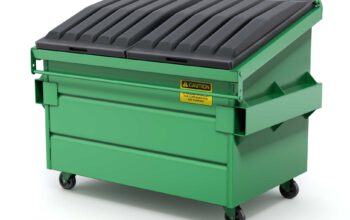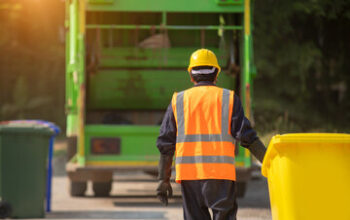Disposing of waste materials is the process by which society gets rid of its discarded items. It is a key aspect of environmental protection and requires properly managing resources and land.
Perth Rubbish Removal offers various services to help people separate their trash. This helps reduce landfill volume, air pollution, and greenhouse gas emissions.

Recycling is an important part of a comprehensive waste management program and can help reduce energy usage, decrease the volume of landfills, and preserve natural resources. The most common types of recyclable materials include glass, paper, metals, and plastics. Many communities and businesses offer curbside recycling programs, which collect recyclables separately from regular trash. Other forms of recycling include composting and incineration. All of these methods should be used in combination. In addition to reducing energy usage, the recycling process also helps to protect the environment and prevent pollution from toxic materials.
The most popular way to dispose of garbage is by sending it to a landfill, but this method has significant environmental impacts. Landfills create groundwater and air pollution and can also cause soil contamination. They may also be a breeding ground for mosquitos and flies, which can spread diseases. In addition, methane, a greenhouse gas, is produced by decomposing organic waste in landfills. This is why many areas are reconsidering the use of landfills.
Another option is to send the trash to a waste-to-energy plant, which burns solid and liquid waste to produce energy. This process also reduces waste volume and is hygienic. However, the exhaust gases from this procedure may be toxic, so they are treated before being released into the air.
In a modern sanitary landfill, the trash is packed into cells and capped to minimize contact with the surrounding environment. The cells are filled with a mix of organic and non-organic waste. The organic waste decomposes anaerobically and produces methane, a potent greenhouse gas. The non-organic trash is compacted into a dense, oblong shape to reduce space.
Another alternative is incineration, which involves the controlled combustion of waste to produce ash and gas. This process is a good choice for disposing of non-biodegradable waste, and it can reduce the waste volume by up to 90%. This process is considered more environmentally friendly than landfills, although it still releases greenhouse gases. In addition, the ashes and gasses can be used to generate electricity.
A popular alternative to landfills, incineration, is a waste disposal method that involves burning trash in an enclosed furnace. This process uses air pollution control systems to reduce the volume of waste and toxic emissions. It also produces ash, which can be reused in construction projects or landfills. Moreover, the heat generated by incineration can be used to generate electricity. This is known as “waste to energy” in the United States. The technology is widely used at contaminated sites, including Superfund sites, as it allows for a faster and more cost-effective cleanup.
In addition, incineration can provide a cleaner alternative to landfills because it does not produce methane, a greenhouse gas that contributes to global warming. In contrast, the decomposition of garbage in landfills produces methane, which can harm the environment and pose a safety hazard for workers. Incineration can also be an effective way to remove dangerous chemicals from a site. The cleanup process can take from a few weeks to several years, depending on the size of the site and the amount of contaminated material.
To make incineration safe for the environment, waste must be carefully sorted and treated before being sent to an incineration plant. This includes removing large rocks and other debris, as well as ensuring that the materials are not mixed together. Specialized waste disposal companies are required to prepare the waste, which is fed into a controlled combustion process. This process burns the garbage and converts it to ash and waste gases, which are then extracted and stored in sealed containers for disposal.
Before being burned, the waste undergoes a comprehensive sorting process utilizing mechanical and manual methods. Oversized items and recyclables are removed, while metals are shredded. The waste is then dried to reduce its moisture content, typically aiming for around 30%. It is then divided into smaller batches, with the volumes being carefully calculated to ensure that the combustion process is as efficient as possible.
While incineration can be a useful alternative to landfills, it is not a green option. It emits carbon dioxide and air pollutants, and it requires a large amount of energy to operate. In addition, the heat produced by incineration can also cause several health problems, especially in low-income communities and communities of color. Studies have linked the proximity of waste incinerators to higher rates of cancers and congenital disabilities.
Biodegradation is a natural process that recycles waste materials and transforms them into more usable products. Its advantages include that it is a non-polluting method and can reduce waste volumes. In addition, it is environmentally friendly and cost-effective. It is also an effective way to remove toxic chemicals from the environment. It can be used to decompose organic and inorganic wastes, and it can even produce useful energy. Microorganisms, such as bacteria, fungi, protozoa, and algae, drive the degradation process. It converts complex organic molecules into simpler organic compounds, eventually dissolving in the soil.
The breakdown of these molecules releases water and carbon dioxide, which are both essential for the growth of living organisms. In addition, it produces energy from the oxidation of organic materials, which organisms can convert to heat. This energy is released through the respiratory and excretory systems. The oxidation of organic matter also results in the formation of mineral species such as CO2 and NH4+ or NO3-. The mineralization of organic material is vital to the biotic cycle because it completes the elemental cycles that make up life on Earth.
In the natural world, most materials quickly biodegrade, including wood and paper. However, many industrial chemicals cannot biodegrade and will remain in the environment for decades or centuries. Therefore, it is important to categorize and dispose of these wastes correctly.
There are two main ways to biodegrade a product: composting and anaerobic digestion. The former involves adding biologically-degradable waste to a compost pile, which breaks down into rich and nourishing soil. The latter is an anaerobic process that uses microorganisms to break down organic waste into gasses and humus. It is commonly used to treat oil spills and is a key part of wastewater treatment.
While both processes can help reduce trash, they have their drawbacks. Composting requires an ideal environment to biodegrade, while anaerobic digestion can produce toxins detrimental to the environment. In addition, biodegradation can be slow or inefficient, and some materials may need to break down fully.
Traditionally, trash is sent to landfills to be permanently stored. In the past, these dumps went unmonitored and bred contamination and disease-carrying pests, but today, they are regulated sites that follow several steps to keep waste safe. One of the most important is to cover the site with a layer of soil, which helps to prevent odors and rodent problems. Then, a perforated pipe collects any liquid produced from decomposing rubbish and funnels it away to treatment plants. Landfills also have gas typically made up of methane and carbon dioxide. It is flammable and can cause explosions, so some landfill sites burn off the gas or use it to generate electricity.
When water seeps through the rubbish, it picks up metals, minerals, organic chemicals, germs, and explosives. This can contaminate soil and groundwater. It also carries toxic substances like lead and mercury, which are hazardous to human health. In addition, the gases emitted by decomposing trash can damage the environment. These harmful gases contribute to global warming and acid rain.
All of these issues can be prevented by following best practices. Those include designing the landfill layout in advance, creating a system to monitor groundwater quality, and providing employment opportunities to nearby people. Some landfills even offer education classes to teach residents about safe landfill operations.
While landfills are a necessary part of modern life, they have many negative impacts on the environment. Landfills leak, pollute water and soil, and emit greenhouse gases, contributing to climate change. They also create odors and attract insects and rodents. However, some newer landfills are experimenting with ways to reduce these effects.
One method is to build an engine that can turn methane into electricity. This technology reduces landfill emissions and produces clean energy. The other is to make the most of the space available in the landfill by storing trash tightly packed to prevent odors and rodents from spreading.
While all forms of trash disposal emit greenhouse gases, landfills are a significant source of these pollutants. They can also contaminate soil and groundwater, which can have serious environmental implications for local communities. In addition, landfills can cause social injustice in low-income or minority communities, where people are more likely to live near a landfill.



